Meet Harley Davidson’s Mosh/CTY e-Bike
By Wayfarer |
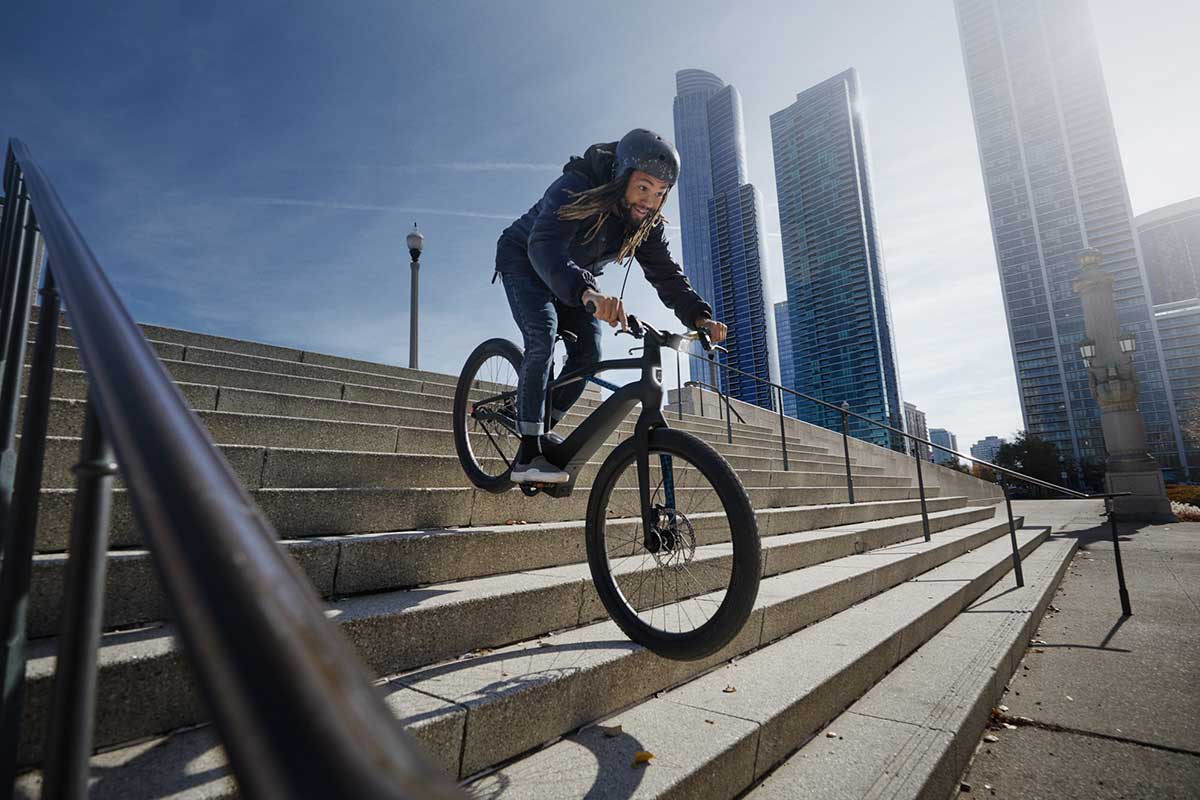 by Cristian Curmei from https://www.autoevolution.com
We have been warned that this was going to happen, and now it is. Harley has released preorders on four beautifully crafted e-bikes from the Serial 1 lineup, and this is the least expensive of the bunch.
Recently, the U.S. motorcycle manufacturer released a very special build known as the Serial Number One, where it showcased electric tech on a tribute bike resembling the oldest known Harley. From there, we got this new wave of two-wheeling ideas.
The first of these bikes from the legendary motorcycle creators is the Mosh/CTY. Now, it’s only first on the list because it’s the least expensive of the lineup and possibly the least capable, depending on how you see things.
Nonetheless, it still brings with it all the history and heritage of Harley Davidson. By now, most fans out there have already asked themselves, why the hell is Harley stepping into the e-bike game? It’s simple, really. It’s a market that’s becoming more and more motorcycle-like.
With advancements in technology, from battery capacity to motor power outputs, our ever-present bicycle is becoming more of a stepping-stone towards an electrified future. So, let’s see what the team has put together for us.
When first laying eyes on the bike, you are struck by a rugged and capable frame that doesn’t resemble any e-bikes. From the start, the frame instills you with a feeling of trust like that one special person in your life.
A lack of suspension means you’ll be feeling your urban terrains, but being made to smash around town, it doesn’t really need anything to soften your ride except the tires and your rubberized knees. Upon closer inspection, the frame includes visible welds. If for any moment you thought that was carbon fiber, now’s a good time to throw away that idea.
What we find on the Mosh, just like on the other Serial 1 bikes, is a hydroformed aluminum frame. But before you start getting upset about Harley’s choice of material, know that it’s the best material for what this bike needs to do and for the price of $3,399. So, relax and read on.
Now, like all things e-bike, the most important aspects are the motor and battery. For the motor, we find a hugely capable 250W Brose S Mag brushless rotor, set mid-drive to offer a perfect balance and center of gravity for the bike. Still, 250W sounds rather weak judging by what we’ve seen so far in the e-bike game.
However, this “half the power of my blender” motor somehow squeezes out 90 Nm (66 lb-ft) of torque, more than some of the biggest and best e-MTBs out there. True, it has a speed cap of 20 mph (32 kph), yet that can be changed if you’ve got the smarts for it.
Powering this sleeper is a 529Wh integrated battery that can also be removed. Now, the range with this set-up is anywhere from 35-105 miles (56-168km), depending on which of the four ride modes you use. Over 100 miles of range; that alone is worth every penny. Once out of juice, a 75% charge takes only 2.6 hours, with a full charge in 4.75 hours.
As for the drivetrain for this smashing e-bike, we find a single-speed freewheel with a Gates carbon drive belt. Top of the line, my fried. As for brakes, Tektro is the brand of choice with two-piston calipers with 203-mm (8-in) rotors.
For some reason, Harley chose to strap on some 27.5-inch wheels and tires. The reason is to ensure all-around control and comfort as 27.5s are highly used in MTB and Enduro biking for their ability to grip and climb while offering ease of maneuverability.
A few other perks like walking assist and internal cable routing are also found, as well as a Brose display and remote that connects to an app. Honestly, for this price, what you get is absolutely amazing. Check out the gallery and video below and then click here to stare at the billing screen.
Watch Video at https://youtu.be/GzP-fwPJNxs
by Cristian Curmei from https://www.autoevolution.com
We have been warned that this was going to happen, and now it is. Harley has released preorders on four beautifully crafted e-bikes from the Serial 1 lineup, and this is the least expensive of the bunch.
Recently, the U.S. motorcycle manufacturer released a very special build known as the Serial Number One, where it showcased electric tech on a tribute bike resembling the oldest known Harley. From there, we got this new wave of two-wheeling ideas.
The first of these bikes from the legendary motorcycle creators is the Mosh/CTY. Now, it’s only first on the list because it’s the least expensive of the lineup and possibly the least capable, depending on how you see things.
Nonetheless, it still brings with it all the history and heritage of Harley Davidson. By now, most fans out there have already asked themselves, why the hell is Harley stepping into the e-bike game? It’s simple, really. It’s a market that’s becoming more and more motorcycle-like.
With advancements in technology, from battery capacity to motor power outputs, our ever-present bicycle is becoming more of a stepping-stone towards an electrified future. So, let’s see what the team has put together for us.
When first laying eyes on the bike, you are struck by a rugged and capable frame that doesn’t resemble any e-bikes. From the start, the frame instills you with a feeling of trust like that one special person in your life.
A lack of suspension means you’ll be feeling your urban terrains, but being made to smash around town, it doesn’t really need anything to soften your ride except the tires and your rubberized knees. Upon closer inspection, the frame includes visible welds. If for any moment you thought that was carbon fiber, now’s a good time to throw away that idea.
What we find on the Mosh, just like on the other Serial 1 bikes, is a hydroformed aluminum frame. But before you start getting upset about Harley’s choice of material, know that it’s the best material for what this bike needs to do and for the price of $3,399. So, relax and read on.
Now, like all things e-bike, the most important aspects are the motor and battery. For the motor, we find a hugely capable 250W Brose S Mag brushless rotor, set mid-drive to offer a perfect balance and center of gravity for the bike. Still, 250W sounds rather weak judging by what we’ve seen so far in the e-bike game.
However, this “half the power of my blender” motor somehow squeezes out 90 Nm (66 lb-ft) of torque, more than some of the biggest and best e-MTBs out there. True, it has a speed cap of 20 mph (32 kph), yet that can be changed if you’ve got the smarts for it.
Powering this sleeper is a 529Wh integrated battery that can also be removed. Now, the range with this set-up is anywhere from 35-105 miles (56-168km), depending on which of the four ride modes you use. Over 100 miles of range; that alone is worth every penny. Once out of juice, a 75% charge takes only 2.6 hours, with a full charge in 4.75 hours.
As for the drivetrain for this smashing e-bike, we find a single-speed freewheel with a Gates carbon drive belt. Top of the line, my fried. As for brakes, Tektro is the brand of choice with two-piston calipers with 203-mm (8-in) rotors.
For some reason, Harley chose to strap on some 27.5-inch wheels and tires. The reason is to ensure all-around control and comfort as 27.5s are highly used in MTB and Enduro biking for their ability to grip and climb while offering ease of maneuverability.
A few other perks like walking assist and internal cable routing are also found, as well as a Brose display and remote that connects to an app. Honestly, for this price, what you get is absolutely amazing. Check out the gallery and video below and then click here to stare at the billing screen.
Watch Video at https://youtu.be/GzP-fwPJNxs
Honda CMX500 Rebel reviewed
By Wayfarer |
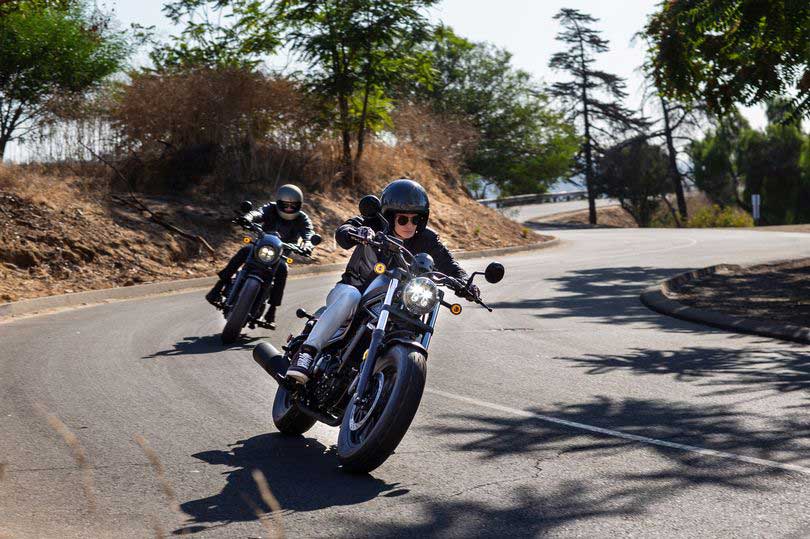
by Geoff Hill from https://www.mirror.co.uk
The original looked a bit wimpish, but a macho makeover has made this cruiser version of the hugely popular CBR500 a nice alternative for bikers clutching their brand new A2 licences in their gloves
A Honda Rebel is a bit of an oxymoron, like Boris Johnson’s hair stylist or Vladimir Putin’s sense of humour.
You see, Hondas aren’t really bikes for rebels. They’re bikes for chaps and chapesses who want to get from A to B efficiently and safely on machines which never break down and have fewer vices than Audrey Hepburn in A Nun’s Story.
Even their Fireblade superbike has always been a pussycat to ride, although in the hands of 23-times TT winner John McGuinness, a pussycat with very sharp claws.
Their cars are the same, as I found doing a lap of Silverstone in a Civic R with British Touring Car champion Gordon Shedden.
I thought it was going to be terrifying, but he and the car were so fast and flawless that it was a hoot going around corners sideways at 100mph while he chatted about the weather.
The one time Honda took a walk on the wild side was with the 1300cc Fury chopper in 2010.
It looked fabulous, but when MCN compared it to the Harley Rocker C, they said the Harley shook and rattled, and engaging first gear was like dropping a hammer in a bucket, but the Fury was too perfect, so they preferred the character of the Rocker.
You could just see the row of heartbroken designers at Honda HQ trudging out to the car park to commit seppuku.
So I rolled up at Belfast Honda on the Africa Twin with some doubts; particularly since when the Rebel came out in 2017 as a bobber cruiser version of the CBR500 which is hugely popular with bikers who’ve just got their lovely new A2 licence and are limited to 47bhp for a bit, it looked, well, a bit wimpish.
Bobbers, as those of you who have studied Dr Furtwangler’s A-Z of Motorcycles will know, were originally 1930s bikes with everything superfluous removed and the mudguards cut back or bobbed for a lean, mean, moody masculine look.
The original Rebel, though, looked about as masculine as Julian Clary in a frock.
All hail, then, to the chaps at Honda who’ve turned Julian into John Wayne, with a much more rugged appearance, not to mention new LED headlight and indicators and a slipper clutch to stop the back wheel locking during aggressive downshifting.
Climb aboard, and it’s still fairly compact for anyone over 6ft, although I was getting vertigo compared to the Monkey Bike I’d been on the week before, joining some lunatics riding them from Land’s End to John O’Groats for charity.
The mirrors are as useful as before, and the minimalist circular speedo now has, as well as the previous time, fuel gauge and mileage on the 2017 version, a gear indicator, a handy addition for newbies.
Start up, the air filled with a civilised purr, and I set off feeling suitably rebellious and looking for some grannies on scooters to beat up.
Progress is surprisingly perky, helped by the fact that the CBR500 engine has been tweaked to deliver maximum torque 500rpm lower. Peak power comes in 100rpm lower as well, not that you’d notice.
Like all Hondas, you can thrash the bulletproof engine to death without fear of disintegration, but the bike’s perky enough without needing to, and that civilised purr never becomes more than a civilised growl anyway.
Handling, with the bike weighing only 190kg fully fuelled and 16in wheels, is a hoot, allowing even new bikers to fling it around corners as if they’ve been riding all their lives, and the suspension damping is better than on the original model as well, leading to a surprisingly plush ride on a smallish budget bike.
There’s only one brake disc up front, but on a bike this light, that’s all you need, with nicely progressive bit and feel from the rear on the rare occasions you might need to go near it.
For an even meaner look, you can detach the pillion seat, which looks about as big and comfortable as a carefully folded napkin, and for another 400 quid, the Special Edition version has a quilted seat, flyscreen for a bit more wind protection at motorway speeds and black fork gaiters for extra moodiness.
The Facts: Honda CMX500 Rebel
Engine: 471cc liquid-cooled parallel twin
Power: 46bhp @ 8,500rpm
Torque: 32 lb ft @ 6,000rpm
Colours: Grey; blue; black
Price: From £5,799
Harley-Davidson Milwaukee Eight Gets Bigger and Meaner
By Wayfarer |
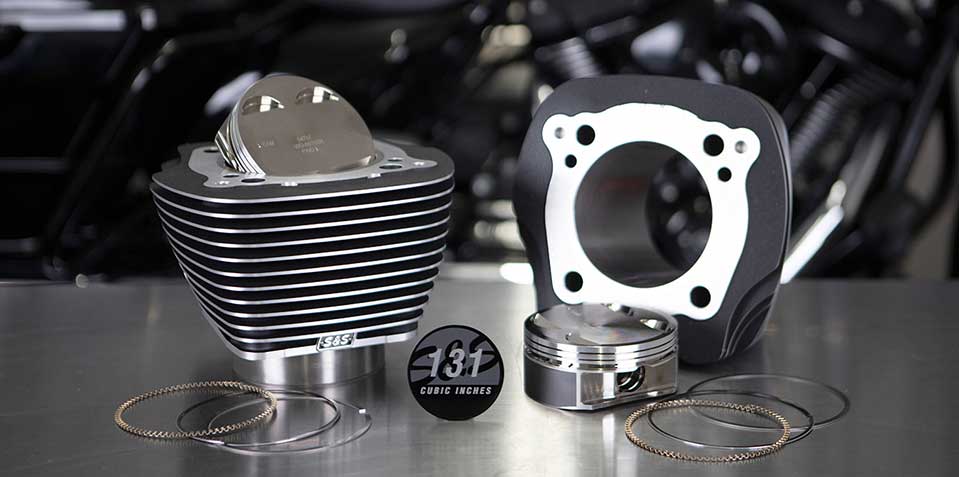
by Daniel Patrascu from https://www.autoevolution.com
Harley-Davidson Milwaukee Eight Gets Bigger and Meaner with New 131 S&S Kit
Do you know that saying “there’s no replacement for displacement?” It applies to all types of internal combustion engines, fitted on both cars or motorcycles, and has been the driving force behind many stunning machines over the years.
In the motorcycle world, Harley’s Milwaukee Eight engine is one of the most famous powerplants. Part of the big twin family that has been around for eight decades, it was introduced in 2016 with a total of eight valves – four for each cylinder – hence the name.
Generally, these engines come in three displacement options, namely 107, 114, and 117 ci. There’s an even bigger variant on the market, the Screamin’ Eagle Milwaukee Eight 131, “the biggest, most powerful street-compliant engine Harley-Davidson has ever created,” but this one is offered as a crate solution.
Those looking to get more cubic inches and more power have several solutions at their disposal. The latest comes from S&S and is designed for Milwaukee Eights fitted on bikes from 2017 to the present day.
Comprising upgrades like a new-design forged piston and 4.25-inch cylinders, the kit can take engines all the way to 131 ci (2.1 liters), but only when paired with the company’s stroker crank – we’re told the upgrade works with stock crankcases as well. According to S&S, the stock engine height remains after the kit is fitted, and so do the original serial numbers.
There are three variants of the kit available, namely Wrinkle Black with highlighted fins, Wrinkle Black with non-highlighted fins, and Black Granite with highlighted fins.
Regardless of the version, the price is $1,299.95, but that increases to $1,529.95 when opting for the stroker crank as well. Still, that should be peanuts given what the hardware offers, according to S&S product manager Grant Hilligass.
“We build our big bore kits and cranks to much tighter tolerances and with higher quality materials than the factory parts,” he states.
See https://www.sscycle.com/
1981 Shovelhead custom
By Wayfarer |
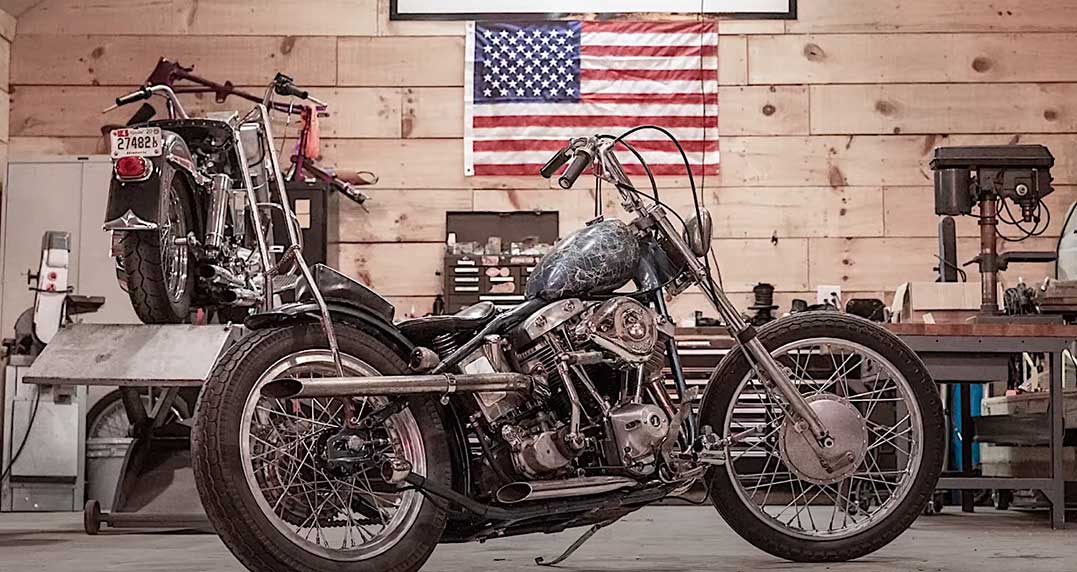
by Daniel Patrascu from https://www.autoevolution.com
Not that long ago, we ran a story about a customized Breakout called Stella. The work of German custom shop Thunderbike, the motorcycle was the perfect opportunity for me to state that Harley does not give bikes girl names.
And it doesn’t. Go as far back as you like in the history of the company, and you’ll see mostly male names, or names that are generally associated with males: Road King, Street Bob, Cross Bones, Iron, and so on.
But Harley riders do give their bikes girl names. That was made clear to me almost immediately by the comments posted on the Stella story, with people saying their Harley bikes have names, not designations, and these names include stuff like Belladonna, Jolene, Delilah, Dolly, Scarlet, or Christine. Someone even said he likes to call his bike Mazikeen (that’s for you Lucifer fans out there).
Back in June, when the world was in full lockdown, and there was no hope of bike shows to be held in-person, 60 builders from 10 countries showed their creations online as part of Harley-Davidson’s The No Show. Among them was North Carolina resident Billy Childress.
His build, a 1981 Shovelhead, is yet another proof that builders and riders like to think of their bikes as being females (maybe Harley should take notice). It’s called Linda, taking the name of the builder’s mother.
Like many projects of its kind, this one, too, was designed with the fuel tank at its core. Starting from that, Childress sourced the rest of the parts and started putting the bike together, from the wheels that make the connection to the ground to the straight exhaust pipe pieced together out of four other pipes, and of course, the Shovelhead engine fitted inside the frame.
Like all other builders in the show, Childress was given a couple of minutes to show his creation and you can watch his presentation in the video attached below.
Sam’s Picks for the Week of December 6, 2020
By Wayfarer |
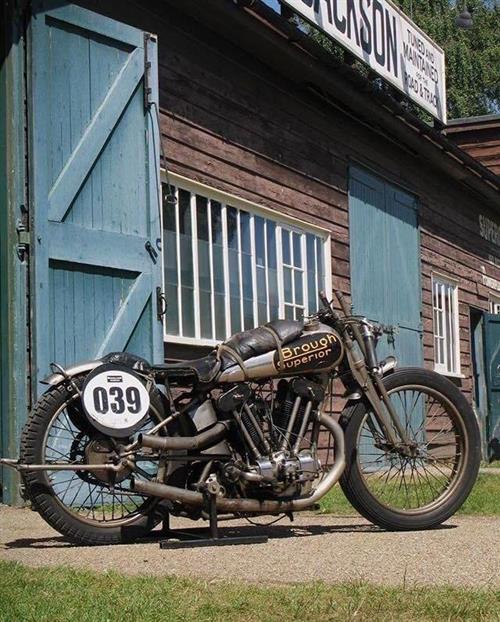
This is a strange one. I’ve been an outlaw most of my life and my drug of choice was women. I don’t know how to explain or if I can. I’m not proud to say, Laurie was one of the first episodes in a series of many. I’m reading a book by Dr. Pat Allen. She says it’s in our genes to chase women for as long as our testosterone levels are raging. It’s the nature of the evil beast to keep our human craziness alive.
Click Here to Read this adventure article on Bikernet
Join the Cantina – Subscribe today
https://www.bikernet.com/pages/custom/subscription.aspx
Harley-Davidson Spoke Bob 21
By Wayfarer |
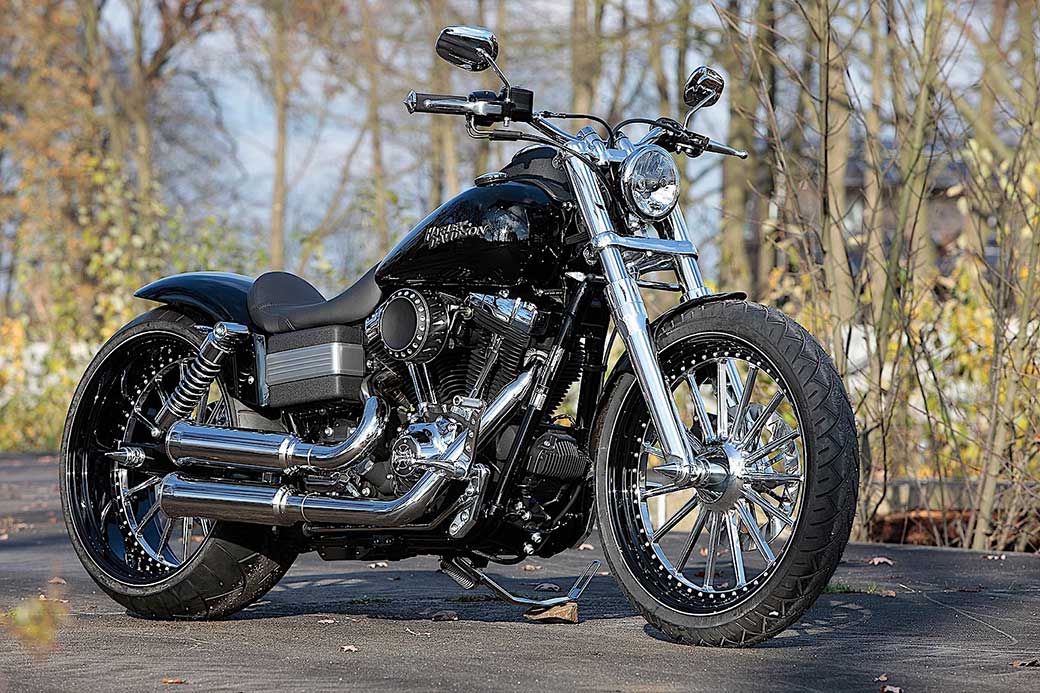
by Daniel Patrascu from https://www.autoevolution.com
When they are not going for a full-blown shocker build like say the one Orange County Choppers used to make, custom motorcycle garages have very few options at their disposal to make their projects stand out. Finding the right wheels is one of the easiest ways to ensure a custom bike sends the right message across.
Having remade literally hundreds of Harley-Davidson bikes over the past 25 or so years, the Germans at Thunderbike know this all too well. Sure, they do make their own custom frames, and when they do wheels are not that important anymore, but when going for a Harley conversion they are essential.
So essential, in fact, that at times these guys even name their builds after the type of wheel used. We’ve already seen the Street Bob-based Big Spoke, and here’s another, the Spoke Bob 21.
Also based on the Street Bob, the motorcycle rides – as its name says – on multi-spoked 21-inch wheels that are sure to catch the eye as they roll down the street. But they are not the only changes made to the two-wheeler.
Thunderbike went in full custom mode for this one, providing their usual complement of modifications in four key areas: fender, saddle, tank, wheels. Aside from these, a forward control kit was fitted, but also a pulley brake kit to go with the build.
In all, around 16 elements went into the making of the Spoke Bob, all of them of Thunderbike design, with the exception of the front and rear signals, supplied by Kellermann.
We are not given any info on how much the motorcycle cost to put together in this form, but a quick math exercise (Thunderbike lists the parts used, and most of them are available in their shop) gives a price in the range of over 7,000 euros – about $8,400 at today’s rates. Of those, about $3,000 was spent on the wheels alone.
Extensive Staged-Accident Scam in New Orleans: NMA E-Newsletter
By Bandit |
As of November 5th, 33 people have been charged in an elaborate staged-accident scam involving slammers, spotters, crooked lawyers, and doctors. All are accused of conspiring to bilk insurance companies and commercial carriers for damages. The local police and FBI investigations are ongoing and more people are expected to be indicted in the near future.
The anatomy of a far-reaching fraud scam like this takes time and coordination. Here are just some of the particulars in the New Orleans scheme.
The Slammer
As a slammer, Cornelius Garrison would drive (with passengers in the car) and intentionally cause accidents with big trucks and other commercial vehicles as they were changing lanes. He would then abandon the vehicle, have one of the passengers pretend to be the driver, call 911, and report the crash. This is called a jump-in, false-claim scam designed to initiate fraudulent medical claims.
One example took place in 2015 when Garrison drove a Dodge Avenger into a bus. According to the indictment, the settlement resulted in a $677,500 windfall, and Garrison’s cut was $80,000.
In September, Cornelius Garrison was shot to death four days after the US Attorney’s Office in New Orleans filed charges. He was accused of staging over 50 wrecks and was murdered amid reports that he had been cooperating with federal investigators. Police continue to investigate his death.
The Lawyer
In late October, personal injury attorney Danny Keating Jr. was indicted for participating in as many as 31 staged accidents. He was charged with one count of conspiracy to commit mail and wire fraud, for conspiring with alleged ringleader Damian Labeaud and others in a scheme to stage auto accidents intentionally. If convicted, Keating will face up to five years in prison and a $250,000 fine.
Labeaud would refer staged accidents to Keating and other as-of-yet-unnamed New Orleans personal injury attorneys. Like Keating, attorneys would receive $1000 per passenger for accidents with tractor-trailers and $500 involving other vehicles. Keating represented 77 plaintiffs in 31 staged accidents and settled 17 cases for approximately $1.5 million.
Overall Costs of Staged Scams
The FBI estimates that the cost of non-health insurance scams cost $40 billion annually. US families end up paying for this with an average cost of $400 to $700 more on insurance each year.
The extensive New Orleans staged accident scam is far from settled, and the number of people involved in the conspiracy is staggering. But staged accidents can happen anytime, anywhere, and sometimes with only a solo criminal driver.
Here are several examples of various road scams:
The Swoop and Squat
Variation 1: Two vehicles working together target an innocent driver with the first fraudster in front and the other pulling up alongside. The first fraudster brakes hard, and the innocent driver rear-ends the first car because they were blocked by the second.
Variation 2: Two vehicles working together target an innocent driver with one fraudster in front who is cut off by the second fraudster causing the first one to hard brake, and the innocent driver read-ends the car.
Variation 3: Same as Variation 2 except with only one fraudster who speeds up along the innocent driver, cuts in, and then brakes hard—the innocent driver cannot escape the rear-end collision.
The Panic Stop
This scenario is similar to the swoop and squat. The fraud car is in front often with several passengers who watch you drive. If you take your eyes off the road for a split-second, the fraud car slams on the brakes. Another rear-ender, and guess what—it’s your fault.
The Wave and Hit or the Drive Down
The fraudster signals with a wave or a headlight flash that it’s safe to proceed to an innocent driver trying to merge or change lanes. The criminal then sideswipes the car, denying later they ever signaled or waved. This fraud is also prevalent in parking lots.
The Sideswipe
This staged accident occurs at intersections with two left-turning lanes. The innocent driver accidentally drifts into the other lane on the turn, or the fraudster does and sideswipes. The scammer will claim the other driver caused the accident. A similar scenario can happen with turning right and leaving a parking space from the curb.
Start-and-Stop
This accident fraud occurs in heavy traffic. The scammer drives ahead of the innocent driver and begins to move but for no reason brakes and forces a rear-end collision.
What can you do?
Avoid becoming a staged accident victim by utilizing the following tips from the National Insurance Crime Bureau (and a few of our own).
- Don’t tailgate. Leave adequate room between you and the car in front of you in case they hard brake suddenly. The National Safety Council recommends the three-second rule by which the trailing driver leaves a three-second cushion of travel time between him and the vehicle in front.
- In parking lots, drive slowly and pay close attention to others driving or walking near you.
- When leaving the curb, be aware of what is happening behind you and proceed with caution.
- Don’t drift into another lane when turning left.
- When turning right, proceed with caution and account for all vehicles, bicyclists, and pedestrians in the area.
- Call the police to the accident scene and obtain a police report (with the officer’s name) even if the accident has minimal damage.
- Use your smartphone camera or a disposable camera in your car to document accident damage and the number of passengers in other vehicles.
- Avoid “runners” and “cappers.” These are people who appear from nowhere, directing you to personal injury attorneys. They are generally part of a broader insurance scam.
- Avoid doctors who insist you file a personal injury claim if you are not hurt.
- Do not allow any tow truck driver who arrives on the scene to take your vehicle. Make your own call for a tow and get the fees upfront in writing. Check out more on this from the NMA E-Newsletter #611—Protect Yourself from Predatory Towing.
If you think you have been involved in a staged accident, call your insurance agent, the police, the state insurance commission, and report it to the National Insurance Crime Bureau by calling 800-835-6422 or submitting a form on the NICB website. If you want more information, download the NICB brochure on Staged Automobile Accident Fraud.
Support the National Motorists Association (NMA)
Pandemics are aided by factory farms
By Bandit |
You could call it “the silence of the minks.”
In Denmark, all the farmed minks in the country — some 17 million of them — have been destroyed after mutant coronavirus strains were detected in animals on many farms. The disease was able to spread and mutate quickly through the cramped cages housing the mink, and sometimes the animals passed the new strains to the humans who tended them. One mink-adapted strain, called Cluster 5, thought to be less responsive to antibodies and thus a possible threat to vaccine-derived immunity and human health, infected at least 12 people. A cull was ordered, and the slaughter began.
Farms in Greece, the Netherlands, Ireland and other countries have also liquidated their minks. Thousands of workers have lost their jobs, and an entire industry has been destroyed.
You have to ask yourself, when will we learn?
Spillover — the transmission of animal disease to people — happens all the time. Plague, which has given rise to the deadliest pandemics in human history, is always caused by spillover from animals, generally rodents. HIV broke into the human species from hunting chimps carrying a related virus. Ebola too is a zoonotic disease, and it’s likely that every outbreak of the disease has come through hunting.
But the far greater threat to human health doesn’t come from spillovers in the wild. It comes from the way we farm and market animals.
SARS-CoV-1, which sprang out of a large, crowded “wet,” or live animal, market in Guangdong, China, in 2002, should have taught us something. Thought to have originated in bats, the SARS coronavirus possibly amplified in civet cats, an animal farmed for the luxury “wild meat” trade in China, before jumping into the human population. At least 10,000 civets were clubbed, strangled, boiled and incinerated in an attempt to thwart the infection, probably to no useful end, as the infection had already jumped into people.
Though it spread worldwide, causing 8,000 cases and 774 deaths, SARS-1 never became a true pandemic or an effective human pathogen. It transmitted late in the course of infection and was eventually eliminated through quarantine and isolation.
SARS-CoV-1 should have been a shot across the bow, but no one paid enough attention, and after a relatively short period, the live animal markets in China were open again.
The pandemic terror caused by deadly bird flu, which evolved to a fury of virulence in the enormous, densely packed industrial farms of Southeast Asia, should have taught us something too. There was a period between 2004 and 2007 when the world was transfixed by the specter of a lethal pandemic of a highly pathogenic bird flu.
That flu, H5N1, fizzled, probably because the receptors through which the virus entered human cells were located deep in the lungs, making human-to-human transmission almost impossible. But other, equally deadly avian flu viruses have evolved again and again on those giant poultry farms, and chickens in the millions have been slaughtered. Each time, a few people died too, but we learned nothing.
The H1N1 pandemic of 2009, which arose out of a giant pig farm in Veracruz, Mexico, a farm half-owned by the huge American conglomerate Smithfield Farms, blew around the word and cost some 36,000 lives. It was a mild pandemic as pandemics go, possibly because prior immunity from circulating H1N1 infections protected many elderly people. Again, we learned nothing.
Giant industrial farms remain, even though it is blindingly, terrifyingly obvious that packing huge numbers of animals together in confined quarters breeds lethal disease. It has happened over and over, and it will go on happening, so long as industrial farms continue to exist.
When even mild virus strains are introduced to factory farms, perhaps from wild birds, the packed conditions make the evolution of deadlier strains inevitable. That’s because the virus no longer has to depend, as it does in wild birds, on keeping its hosts mobile in order to spread. Cramped conditions make transmission of even the deadliest flu strains easy.
SARS-CoV-2, the coronavirus that causes COVID-19, is believed to have arisen in a huge indoor market with 1,000 stalls and untold numbers of animals of different species. Its evolution, under those circumstances, was predictable, even inevitable.
Now, as over a million people worldwide have died from this newest pandemic, with no sign of the virus altering its course and becoming less virulent, it’s the minks’ turn to die.
You have to ask yourself, when are we going to stop raising animals in conditions where the evolution of deadly disease is absolutely predictable?
Wendy Orent is the author of “Plague: The Mysterious Past and Terrifying Future of the World’s Most Dangerous Disease” and “Ticked: The Battle Over Lyme Disease in the South.”
Horny Air Horn by Air Stream Studios
By Wayfarer |
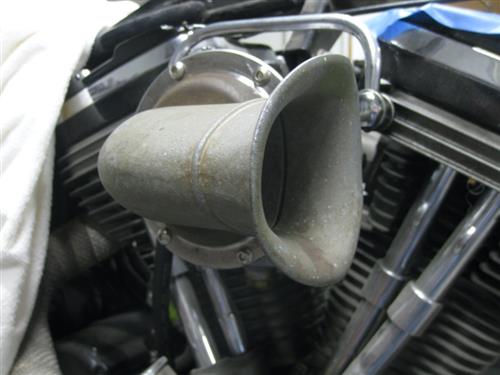
I thought you might be interested in seeing my ‘Horny Air Cleaner’ featuring part of an original ’34/’35 bugle Ford horn. I couldn’t make this puppy live without a kustom backing/mounting plate, made by my good friend Lee Wimmer of Wimmer Machine.
Click Here to See this Fun Feature at Bikernet
Join the Cantina – Subscribe Today
https://www.bikernet.com/pages/custom/subscription.aspx
Harley-Davidson Street Devil
By Wayfarer |
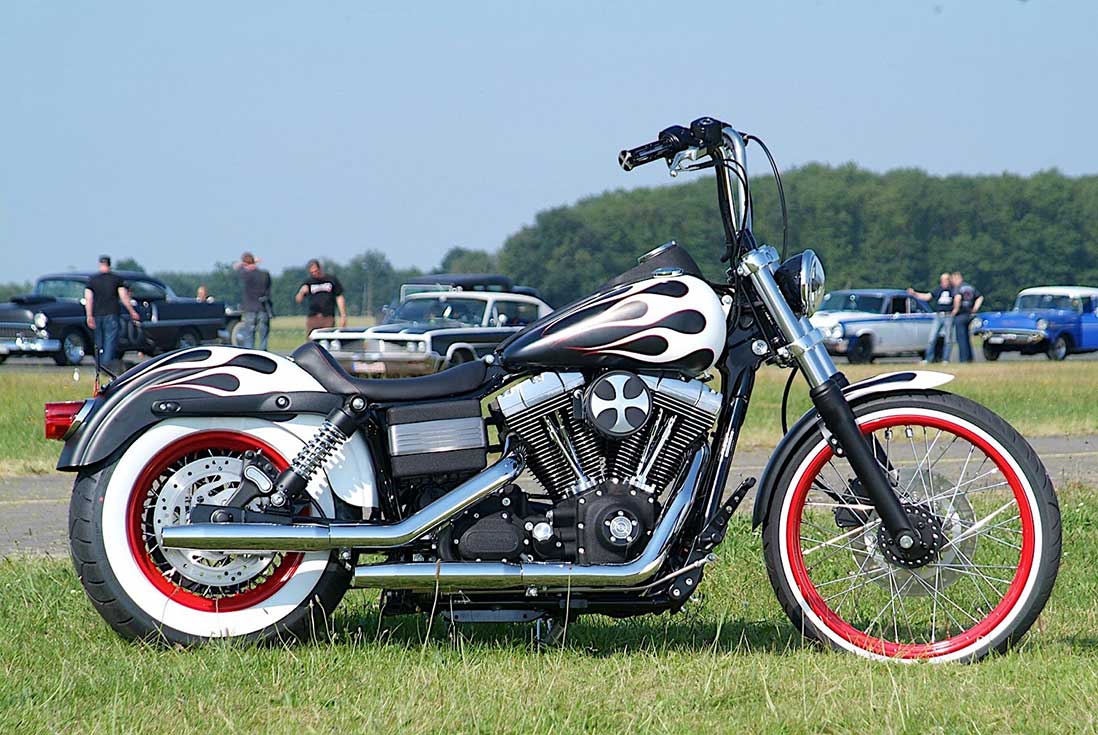
by Daniel Patrascu from https://www.autoevolution.com
For people living in most parts of the world, motorcycle riding is pretty much over this year. Winter is upon us, and two-wheelers are being tucked away until the hot days of the spring and summer reach us once more.
But as we prepare to celebrate Christmas, we can’t stop from continuing to show you the incredible builds coming from Germany, out the doors of a garage called Thunderbike. For the past 25 years or so, these guys have rolled out literally hundreds of Harley-Davidson-based builds, and their work only seems to be accelerating.
For today we’ll focus on a slightly older project of theirs. Called Street Devil, it too is based on the Street Bob (a 2006 model), one of the favorite canvases of the shop.
As usual, the bike has been modified in key areas, namely by tampering with existing or adding new hardware – these new parts are either of Thunderbike or Harley make.
The bike’s twin-cam engine has remained pretty much unchanged, but breathes through a new shotgun exhaust with tapered mufflers made by the Germans. They are also responsible for the engine cover, air cleaner, grips, forward control kit, and seat.
The Americans supplied the fuel and oil tanks, rear fender, shortened front end (by 2 inches), and the lowered suspension (by 1 inch), among others.
The bike rides on custom wheels wrapped in Avon tires and the front and Metzeler at the rear. Just like the rest of the build, and to be in tone with it, the wheels come in red and white – the graphics on the motorcycle is the work of Thunderbike’s favorite partner in this area, Kruse Design.
The shop gives no indication as to how much the build of the Devil cost to make. Usually, we have a way of giving you an estimate on the cost, because Thunderbike uses mostly in-house made parts, and we know the pricing for those. But given the large quantity of Harley hardware still fitted on this one – and we’re not being told from where they were acquired – this is an almost impossible task.



